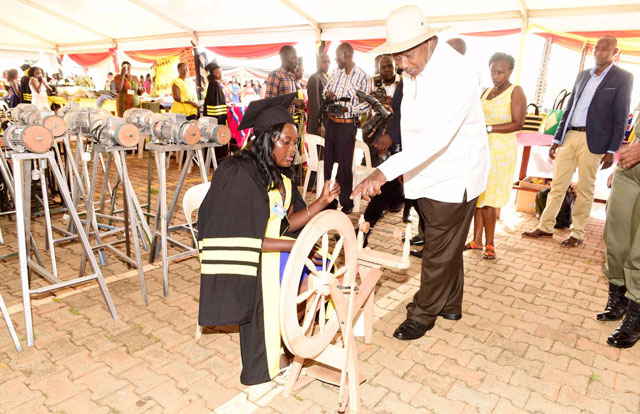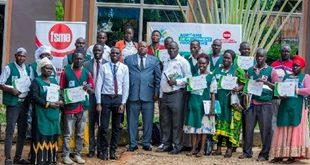
Museveni favours local textiles
Meeting the United States Undersecretary for Political Affairs, Thomas A. Shannon, at Uganda House in New York City on Sept. 22 during the 72nd session of the United Nations General Assembly, President Yoweri Museveni said his government is against importation of second hand clothes because it is trying to develop its textile and apparel sector.
“Second hand clothes are killing the textile and apparel sector in Uganda. Industrialization of this sector is not only good for Uganda but for America as well. As partners the volume of trade grows and creates more incomes,” he said.
Museveni’s remarks were in response to the US Trade Representatives (USTR) earlier statements saying it was reviewing trade benefits to the region under the African Growth and Opportunity Act (AGOA).
This was after US traders in second-hand clothes complained about EAC plan to import used clothes arguing that the move would hurt their industry and also violate AGOA rules.
AGOA, which was extended last year, allows exporters from African countries that meet given terms, to export their goods into the U.S. without the usual tough restrictions. In turn, America also gets some preferential treatment of their products.
Right timing
This new development coincides with the government plans to revive its cotton industry, one of the country’s foreign exchange earners in the 1970s.
In addition, there has also been a surge in demand for cotton as raw materials from domestic mills and the potential to supply manufacturers producing clothes and textiles abroad.
At the moment, the country produces merely 110,707 bales per annum, grown in more than 60 districts in Busoga, Bukedi, Bugisu, Teso, Lango, Acholi, West Nile, and western regions employing thousands of Ugandan households.
With new investors joining the sector, amid government’s commitment to inject more cash in the sector, more Ugandans are set to get jobs right from the farm and in the value adding chains.
Uganda’s textile industry was founded in the 1950s and 1960s, spearheaded by the Uganda Development Corporation (UDC) that worked in tandem with the international partners, such as the Calico Printers Association of the United Kingdom and Yamato International of Japan, as well as domestic partners, such as Nyanza Textile Industries Limited (NYTIL) in Jinja, Mulco Textiles in Jinja, African Textile Mills (ATM) in Mbale and Lira Spinning Mill in Lira, according to Fredrick Lugojja’s background paper prepared for the United Nations Conference on Trade and Development in March this year.
Under the auspices of UDC, a National Textile Board was established in late 1960s to guide the development of the textile industry in the country, with a focus on import substitution.
This, Lugojja said, was followed up with the nationalisation of the textile firm in 1970’s and later liberalised in 1994 where government divested its shares in these textile firms.
“Nevertheless, in the early 1990s, the sector collapsed under the burden of obsolete machinery and other operational constraints, especially unreliable and expensive electricity,” he said.
As at May this year, there were only three operational textile firms in Uganda including Southern Range Nyanza Limited, an integrated textile and garment manufacturing unit based in Njeru, Buikwe District.
However, the textile firms are not operating at full installed capacity due to the high cost of production and low demand for locally produced fabrics and garments as a result of high competition from cheaper imports and second-hand clothes.
As a result, domestic consumption of lint remains low, at an average of 3.3% of the total lint produced. Idle spinning capacity also exists, in the form of the non-functioning Lira Spinning Mill.
 The Independent Uganda: You get the Truth we Pay the Price
The Independent Uganda: You get the Truth we Pay the Price



Hello,
Good day to you!
Greetings from Ramyam Exports – India…
We would like to introduce ourselves as one of the leading exporter for Garment’s consumable materials from India. .
Our products:-
1. Sewing and printing machine accessories
2. Cutting and spreading machine spares
3. Ironing tables and box accessories
4. Electric and Electrical materials
5. Fabricated material (Tables, racks, bins, trollies, pallets, etc.)
6. Packing materials and cotton boxes
7. Paper rolls and Poly films
8. Barcode label and ribbons
9. Printing and stationery items
10. Tools and accessories etc…
We welcome your enquiries on any products to serve you with best competitive price.
One of the best solutions for the Garments.
Thanks & Regards,
U.Rajeshkumar︱Ramyam Exports︱India
Mob: +91 95006 43839︱+ 91 74488 53241
i would like to buy cuttings or material for tshirts which are sold in
kilograms that i can also make tshirts out of it preparedly blue and
red colors please let me know is we can do business
thanks
michael
—
—
10 February 2020
Re: Social Issues & East African Politics
Dear Heads of Organizations,
The problem which we are experiencing is still being investigated by God. For my part, I have to decipher what the long standing problem has meant to me, and what to do about it. The fallout includes women’s issues, such as repair of colour and supply of goods and services to women. For example, I was fought a lot about the clothes which women are permitted to wear, and that leads me to believe that the white Americans wanted to deprive me and women in general of a good supply of clothes. There is oppression over the colour blue, and that type of psychological problem has to be removed. In addition, the manufacturers of women’s clothing have to once again be able to make clothes easily, and to supply them to women in the way which they used to do. The Bukiga was the main culprit, and he fought long and hard about what women should be able to wear. I believe that he was not entitled to his quarrel, and he shall be removed. Thinking back, even at Kenya, there were hints that such a quarrel was brewing, but the main belief was that there was a cultural issue behind the problem, and so I would not be affected. Even today, I am told that I’m Mindanao, which is true, and that means that clothing is not to be a problem for me. But the problem is actually more serious than that. We are now to believe that white societies around the world are experiencing a psychological problem somewhere about women and the way in which women look. The definition of white society requires examination because of the controversy which arose when some people had their colours written for them by other people who then decided to quarrel with the rightful identification of people and tribes. It is actually wrong to permit a widespread and hidden problem about who is white or female in the world, and that is the present situation which the world is experiencing. That type of problem can lead to labour and employment problems when building factories for clothes and other items, so the problem really shall have to be fought. The white Americans, (another incorrect identification) also quarrelled as though they were entitled to institute their own type of racial politics at certain parts of the world, and that means that certain countries are vulnerable to disputes which pertain to women. It is not tolerable to continue to perpetuate a problem where women are being fought for their colour and tribal entitlements, and so we are to seriously begin to remove the dispute of just who a woman is. We are carefully moving away from a broad exposure to the problem, but there are many lingering problems. Those of us who were brought up as women who are not white expect to be able to wear the clothes of our choice, but that means that in the world, we might be fought about femininity and colour. We are occupants of this planet, and so the men of our tribes are to also design a solution to the problem. As far as factory and workplace design is concerned, we have previously mentioned the issues which took place at New York Republic when I worked at a bank. At the factory at New Jersey, the people who were called “management” were black from other countries, so we still don’t have good information about the local people. The other employees were a representation of the people, but we should go back and gather the proper type of data which is required in order to serve the societies of that continent. Here at New Zealand, public health issues are still to be solved. The behaviour of having a large group land at Auckland, and then start dispersing to Taupo, Tauranga and then to Antofagasta is not a good phenomenon. There are still questions which have to be answered.
Sincerely,
June Wanjugu Akena Sheremetyevo Opeto Selassie
13/88 Nelson St.
Auckland Central, Auckland
New Zealand.
Am a Kenyan and experience mechanic I can repair more than 6type of machines.namely
Overlook
Single needle
Flat lock
Double needle
Cutting machine
Feeding of the arm FOA}`
Chain machine.
Hi , I am Sonia and just had a chance to eead this article. I would like to find out whether you have similar access to articles pointed towards the fashion industry in Uganda preferably teen fashion.
Dear Sir/ Madam,
Can you supply any of this product T-shirt , Drilling pipes, Sanitizer, Towel by contract?
Hi
Im saliya jayasinghe .from sri lanka hear im im doing business promotion orders .mean t shirt .cap .bag i can handle cutting to packageing .